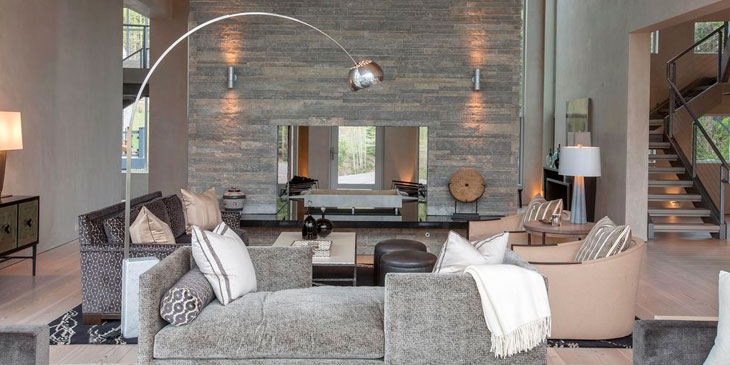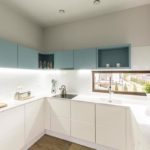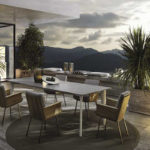Does the perfect living room decoration exist?
Of course it does, the point is that there is not just one perfect living room, but many. There are as many perfect living room decorations as there are people. A living room is an area that’s almost as personal as a bedroom. We will try to answer the question you may be asking yourself right now: How should I decorate my living room?
When it comes to decorating your living room, each person has a different idea of their perfect room. For example, you may like more ample rooms where space becomes the protagonist. On the contrary, you may prefer smaller rooms in which warmth and comfort call the shots.
However, it’s very likely that the room we have at home isn’t our ideal living room. But don’t despair, by paying attention to a series of basic aspects, we can get the most out of ours.
We’re going to show you a number of ideas for decorating a living room that we hope will help you. The first thing to consider is the amount of space we have available and our preferences when decorating it.
You have to use creativity to decorate your living room, without forgetting that it’s important for there to be a common thread between the decor in all rooms of the home. If we’re able to maintain this common thread and also convey what we like most in interior design, we’ll manage to achieve a cosy living room.
The room’s lighting plays a fundamental role in this matter. We’ll dedicate a special section to it later on.
Next, we’ll explore those aspects that will help us turn your living room into your ideal space:
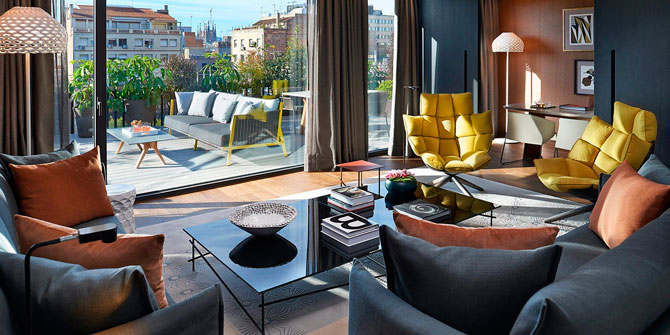
Inspiration and Ideas for Decorating a Living Room
Before thinking about the colours or the living room decoration itself that we want, we need to first consider its functionality. Therefore, we must ask ourselves what we want for our living room. Do we want it to be comfortable? Do we want storage spaces such as shelves or cabinets? Should it be flexible? What will we use it for?
Once we’ve answered these questions, it will be much easier for us to decorate the living room.
We must choose furniture that we like and that fulfil their function. The priority with these two elements will come from our own personality and what we want our room to be like.
Once we’ve chosen the furniture to include, we should think about the decorative accessories.
This part is even more personal than the previous aspects, if that’s even possible. What’s interesting about accessories is that they’re easier to replace than the furniture itself. By that we mean that we can keep up with the latest trends in living room decoration, while always paying attention to our own tastes and the different roles that the room has in our lives.
If we’ve managed to follow the same line of action that we established at the beginning: harmoniously align the rest of the house with the living room; we will be putting our personal and cosy touch on the living room, based on just a few characteristics such as space, functionality and harmony.
Tips on How to Decorate a Living Room
Opting for a classic look is usually a very good idea when it comes to decorating a living room. If we go for the basics, adapting our living room will be much easier than if we start investing in the latest trends.
Acquiring a piece of furniture is usually something we’ll have for a long period of time, we need to consider its useful life and if it’ll be able to withstand passing trends.
Avoid compulsive purchases. A well thought-out decision when acquiring a piece of furniture or decorative element will leave a better taste in our mouths than a rushed purchase.
Assessing the characteristics of our living room, as well as its decoration and style, will help us to ensure the purchases we make are better suited to what we want.
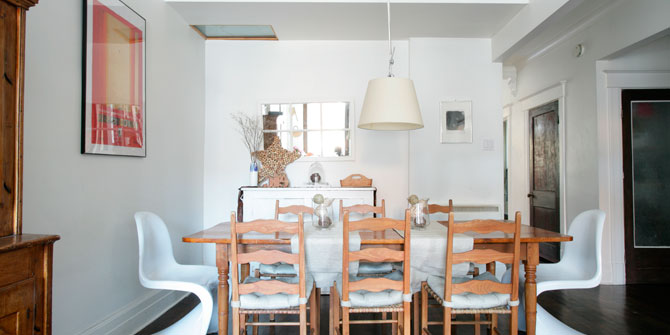
How to Decorate a Small Living Room
In theory, we should avoid bold designs in small living rooms. We’ll focus on colours that multiply the size of the space.
We can use light to make the space appear bigger, so it’s a good idea to not cover the windows or the light that enters through them with furniture or curtains that darken the room. This will allow natural light to fill the space.
Another small trick to make the space appear larger is to select furniture whose colour is the same as the floor or walls, in order to create an optical illusion that compensates for the lack of square metres.
Lighting in the Living Room
Lighting is usually the last thing we think about when decorating a living room. We have to take into account just how important light really is in our rooms. Light is capable of transforming a room, making it seem either cosier or colder. It can highlight elements and provide a sense of comfort that wouldn’t exist without it.
Ideal Characteristics of Living Room Lighting
Our living room is usually a multi-purpose area, that is, it fulfils many functions. A living room isn’t only a space for interacting with others, but is also used to relax, read, study, watch TV… Therefore, you need to include lighting for each of these functions. The lighting should be flexible and comfortable and, if possible, adjustable as well.
In the living room, we’ll also find different areas (such as a storage area, the TV area, the reading area or the dining area). We’ll discuss the characteristics of each of them separately since they require different types of lighting.
For the TV area, we’ll have to take into account the fact that it’s usually the focal point of our living room and where the furniture usually faces. To compensate for the intensity of the screen and to make sure our eyes don’t suffer from the changes in colour contrast, we shouldn’t watch TV in a space that’s overly bright or very dimly lit; the ideal thing to do would be to place a soft lamp behind or near the TV.
If we have a flat screen TV, we can place a LED strip around it so that our eyes can rest.
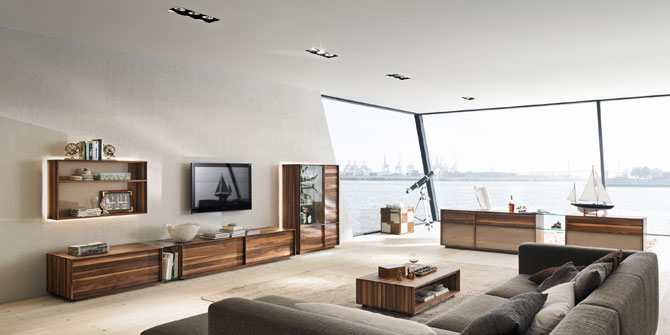
The storage area is that area of the living room where we place tableware, books, pictures, etc. There are several ways of illuminating it; one of them is to use functional lighting with which we’ll be able to quickly find what we’re looking for. We can also use decorative lighting that differentiates this area from the rest of the room and draws more attention to it.
We strongly recommend the use of LEDs for this lighting so that you don’t have to worry about your electricity bill.
For a suitable reading area, we need to have a beam of light that’s concentrated in a reduced space. Ideally, it will be height adjustable.
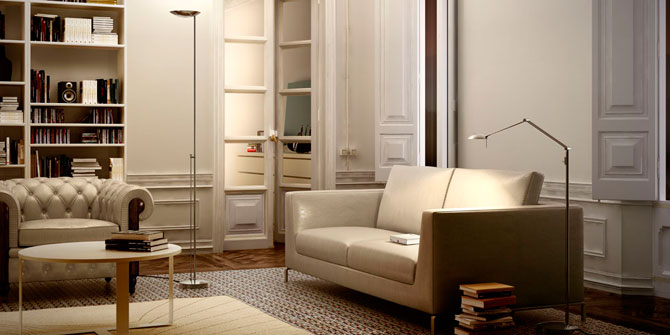
From here, we recommend using a floor lamp behind the sofa or the armchair where we are going to be reading or studying. Adding in a table lamp will also be very useful, always trying to make sure the light comes from above; this way, we’ll avoid shadows that make it difficult for us to read.
The dining area is usually attached to the living room or is even part of the same room itself. We must find a balance between the two environments.
To do so, we can use a pendant lamp that lights up our food and dishes without drawing our attention to other decorative areas; this can be achieved by placing the pendant lamp approximately 70 to 75 cm above the table. This is a crucial detail that will help create a pleasant atmosphere, making sure your dinner parties go on for hours.
We recommend pendant lamps that are adjustable in both height and intensity to truly adapt it to our needs.
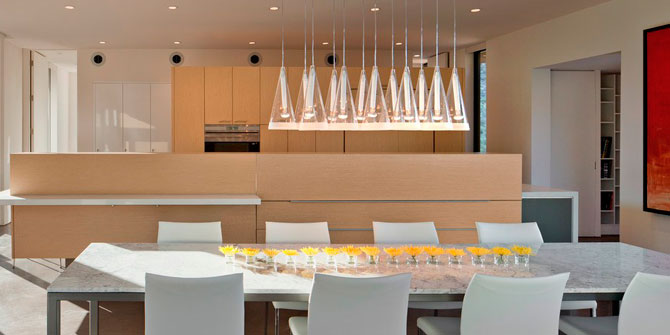
In the area used for relaxing and interacting with others, it’s best to opt for diffused lighting, whether floor or table lamps. We will be creating a relaxed and laid-back atmosphere where we’ll have conversations and won’t want to be put in a spotlight.
Lamps with dimmers help us create the atmosphere we are looking for.
Types of Living Room Lighting
There are four types of lighting that we can use in our living room. Let’s take a look.
Natural light
Natural light is able to bring a lot of warmth to our living room. In addition, it allows us to save energy, which we’ll appreciate on our electricity bill. It’s therefore very interesting to take advantage of natural light to the extent possible.
To get natural light to be a part of the lighting in our living room, one good idea is to place mirrors that reflect it. However, we have to be careful and make sure those reflections don’t become bothersome.
We also have to consider reflections on TVs and screens that make it difficult for us to view them and can lead to eye fatigue.
Another interesting thing to do is to place thin curtains that let the light through, while also giving us some more privacy.
Also, you should take into account the use of light colours on walls, floors, furniture and accessories, as well as bright finishes; this will cause the light to flood the room. We need to avoid placing these pieces of furniture and accessories where the rays of light can touch them, to avoid generating the opposite effect.
As we can see, good natural lighting is achieved by playing with all these elements. It may seem a bit overwhelming at first, but if we follow these recommendations, with just a little bit of effort, we’ll have a room full of natural light.
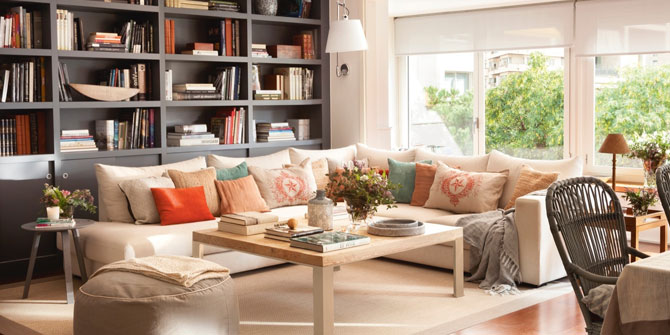
General lighting
This lighting is the foundation for the whole room. It is essential for general lighting to be uniform and without shadows so that the room can quickly be seen at a glance. It’s the coldest light and the one we first turn on when we enter the room. Therefore, it’s highly recommended that these light switches be placed at the entrance.
There are several options when it comes to a room’s general lighting. We can use one or several pendant lamps (depending on the size of the room); wall lamps scattered throughout the room; or ceiling lamps with movable light bulbs so that the light reaches every corner.
Ambient light
In our living room, we have different areas for doing different tasks. Each of these areas requires adequate ambient lighting.
This lighting is actually what usually makes the living room feel cosier, and will invite us to stay and watch TV or chat. Floor and table lamps are often used for ambient light.
We recommend those lamps that have an intensity regulator, or dimmer. With this system, we can adjust the lighting even better and we can enjoy the ambience we want.
Although floor and table lamps are most frequently used for this type of lighting, it is also possible to use LED strips, wall sconces or basically any decorative light that can serve the same purpose.
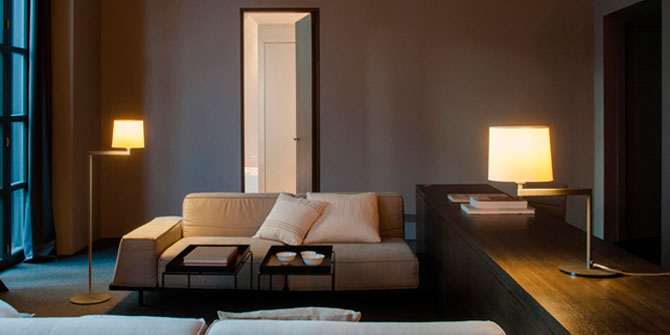
Spotlights
This is the light we use to highlight an area, such as a charming corner, a specific object like a painting or shelves… or for very specific activities such as reading or sewing, for example.
Normally it’s the least necessary type of lighting, but if we know how to use it properly, we can take our living room decoration to the next level.
The most commonly used light fixtures for this type of lighting are those spotlights that shine light on what we want to highlight.
Types of Lamps for Lighting up a Living Room
Living room ceiling lamp
Today, we can find many different types of designs that can be perfectly integrated into the style of any living room. It won’t be difficult to keep this decoration consistent with the style of the rest of the house.
Note: Don’t confuse ceiling lamps with pendant lamps.
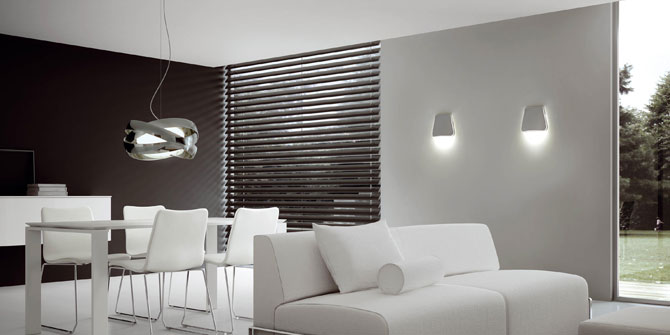
Living room pendant lamp
Pendant lamps are usually used over the dining area or have the function of establishing the general lighting in the room. However, they can be used for other purposes, especially when they come with a dimmer. If we use this lamp for general lighting, we will have to take into account the fact that it’ll likely be placed in the centre of the room and will play a prominent role in our living room decoration.
It’s important to choose a lamp that gives the room personality. We have to make sure we continue to achieve that harmony between the furniture and accessories in the room. We already know that the first impression counts a whole lot.
Undoubtedly, the pendant lamp that we have in our living room will greatly influence the first impression we create with our guests.
Living room floor lamp
In addition to serving as an element for decorating a room, these lamps are often used for ambient lighting and for the reading area. Living room floor lamps usually come in a variety of different designs and we need to be clear about what function they’ll serve in our living room.
On the other hand, if the function of our floor lamp will be to serve as a spotlight for reading, we recommend not using a halogen bulb. This type of light bulb generates a lot of heat over short distances, so it’s preferable to choose a table lamp or a flexible wall lamp.
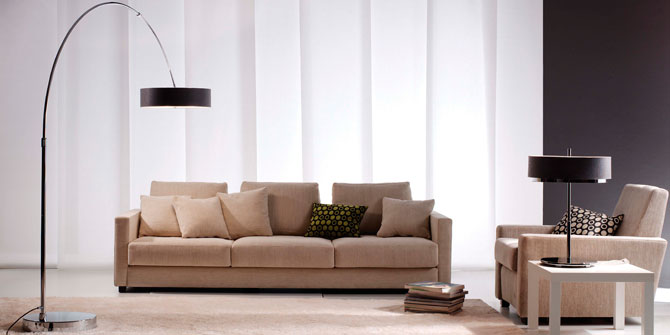
Living room table lamp
Table lamps are commonly used as a decoration element, in addition to serving as an ambient light or spotlight.
The wide variety of designs available for this type of lamp makes it possible to adapt it to any aesthetic in our living room decoration. The type of shade will define how intense the light is, so it’s a very important feature when choosing our table lamp.
Glass or translucent shades generate enough light for display or work areas. While to achieve a softer light, we recommend choosing an opaque or dark screen such as those made of fabric.
Living room wall lamp
These lamps also usually serve as a decorative element in the living room. As a source of ideas for our living room decoration, if we opt for these lamps to generate ambient light, we’ll need to place them far away from our pendant lamp.
With this what we’re trying to do is not weigh down the aesthetics of the room. To ensure that neither one of them interferes with the other.
Their functionality is usually very different, as are their designs. From their use as ambient lighting to being used as a spotlight for showcasing paintings or other elements that we want to highlight; or even for reading.
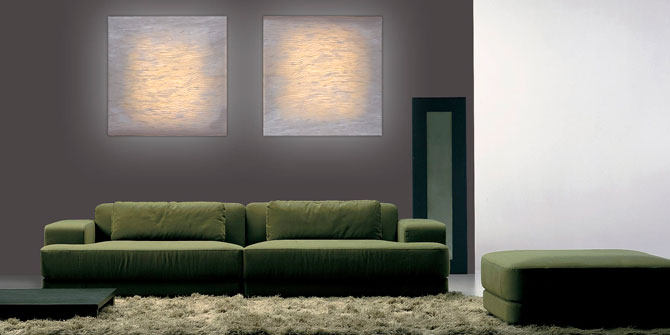
Keys to Lighting up a Living Room
The lamps we choose for our living room decoration serve a dual purpose. They light up the room and they also serve as decorative element. In many cases, the decorative factor is of greater importance than the lighting itself, therefore our lamps may gain prominence in the aesthetic of the room.
Thus, we need to carefully choose our lamps, since implementing the decoration ideas we have in mind for our living room is something that requires patience. Regardless of the types of lamps we want for our living room, the idea is to create different ambiences in each space.
We recommend choosing lamps that are different from one another. That way, not only will our room be cosy, but it will be far from boring.
To light up bookcases and to be able to find what we’re looking for at a glance, it’s a good idea to place clip-on lighting appliques on the shelves. A 20-watt bulb would be perfect for lighting up the area, without it being too bright.
We must take special care when lighting up paintings or sculptures that we want to draw attention to so that their colours or shapes don’t become distorted, and we must also make sure no reflections are produced on the glass, if there is any.
For the sofa area, it’s highly recommended to have a low-intensity light nearby that illuminates the space without blinding us. We can achieve this with a floor lamp near the sofa that faces it, although table lamps could also be used.
If we’ve decided to go with ceiling lamps or a recessed light fixture, it’s highly recommended to use LED recessed lights around the perimeter of the room. This way, the entire room will be lit up and all the light will be distributed throughout the room.
We may find that recessed ceiling lights are the perfect choice for the living room’s general lighting. If we place them with a distance of one metre between them, we will ensure no shadows are produced. And if we put them on different light switches, we can turn them on separately and thus be able to adapt the lighting to our needs.
We need to mention that you shouldn’t overdo it when it comes to recessed ceiling lamps. They can create a cold and impersonal ambience that we wouldn’t like to have in our living room. If we finally decide to go with this option, we will have to avoid placing them over the television so that they don’t bother us when watching TV.
Finally, it’s interesting to note that the type of light we choose and the lighting we apply in our living room will produce different shades of colours on the walls, furniture and accessories. So it’s important to try things out until achieving the desired effect.
If you follow all these recommendations and use your imagination to decide on your living room decoration, you’re sure to achieve a striking new look. Both you and your guests will notice it when they enter the room.
And now that you know how to use light in your living room decoration, anyone who comes to visit will feel comfortable and will be inclined to stay longer.

